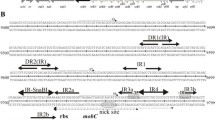Abstract
An ampicillin resistance plasmid carrying the cloned repressor gene cII of the L phage (Salmonella lyphimurium) was conducted by F’lac into an F- recipient. Two types of plaamids were isolated from Apr transconjugants. The majority of plasmids were dimers with one copy of Tn1000 inserted, the minority being monomers with one copy of Tn1000. This proportion remained unaltered when we used the F’lac strain transformed with a monomeric form of the recombinant plasmid as a donor. An extensive oligomerization of pBR322-originating plasmids was proved in the presence of F’lac; its presumable relationship to transposition-related processes is suggested.
Similar content being viewed by others
References
Appleyard R.K.: Segregation of new lysogenic types during growth of a doubly lysogenic strain derived fromEscherichia coli K12.Genetics39, 440–452 (1954).
Barbour S.D., Nagaishi H., Templin A., Clark A.J.: Biochemical and genetic studies of recombination proficiency inEscherichia coli.Proc.Nat.Acad.Sci.USA67, 128–135 (1970).
Bedbrook J.R., Lehrach H., Ausubel F.M.: Directive segregation is the basis of ColEI plasmid incompatibility.Nature281, 447–452 (1979).
Birnboim H.C.: A rapid alkaline extraction method for the isolation of plasmid DNA.Methods Enzymol.100, 243–255 (1983).
Bolivar F., Rodriguez R.L., Greene P.J., Betlach M.C., Heynecker H.L., Boyer H.W., Crossa J.H., Falkow S.: Construction and characterization of new cloning vehicles. II. A multipurpose cloning system.Gene2, 95–113 (1977).
Boros I., Póstfai G., Venetianer P.: High-copy-number derivatives of the plasmid cloning vector pBR322.Gene30, 257–260 (1984).
Boyer H.W., Rouland-Dussoic D.: A complementation analysis of the restriction and modification of DNA inEscherichia coli.J.Mol.Biol.41, 459–472 (1969).
Cohen S., Chang A., Hsu L.: Nonchromosomal antibiotic resistance in bacteria: Genetic transformation ofEscherichia coli by R-factor DNA.Proc.Nat.Acad.Sci.USA69, 2110–2114 (1972).
Fishel R.A., James A.A., Kolodner R.:recA-independent general genetic recombination of plasmids.Nature294, 184–186 (1981).
Goto N., Shoji A., Horiuchi S., Nakaya R.: Gamma-delta-mediated mobilization of plasmids, pp. 39–43 inDrug Resistance in Bacteria (S. Mitsuhashi, ed.).Japan Scif.Soc.Press, Tokyo 1982.
Goto N., Shoji A., Horiuchi S., Nakaya R.: Conduction of nonconjugative plasmids by F’lac is not necessarily associated with transposition of the gamma-delta sequence.J.Bacteriol.159, 590–596 (1984).
Guyer M.S.: The gamma-delta sequence of F is an insertion sequence.J.Mol.Biol.126, 347–365 (1978).
Guyer M.S.: Uses of the transposon gamma-delta in the analysis of cloned genes.Methods Enzymol.101, 362–369 (1983).
James A.A., Morrison P.T., Kolodner R.: Genetic recombination of bacterial plasmid DNA.J.Mol.Biol.160, 411–430 (1982).
James A.A., Morrison P.T., Kolodner R.: Isolation of genetic elements that increase frequencies of plasmid recombinants.Nature303, 256–259 (1983).
Karlovský P., Kuhrová V.: Specific binding affinity for DNA of the L phage (Salmonella typhimurium) in extracts ofEscherichia coli.Mol.Biol.Bep.11, 43–46 (1986).
Karlovský P., Soška J., Reich J., Kuhrová V.: Physical map of the bacteriophage L (Salmonella typhimurium).FEMS Microbiol.Lett.25, 117–120 (1984).
Krivonogov S.V.: The recF-dependent endonuclease fromEscherichia coli K12. Formation and resolution of pBR322 DXA multimers.Molec.Gen.Oenet.196, 105–109 (1984).
Kusher S.K., Nagaishi H., Templin A., Clark A.J.: Genetic recombination inEscherichia coli: The role of exonuclease I.Proc.Nat.Acad.Sci.USA68, 824–827 (1971).
Linder P., Churchward G., Caro L.: Plasmid pSC101 replication mutants generated by insertion of the transposon Tn1000.J.Mol.Biol.170, 287–303 (1983).
Lorence M.C., Rupert C.S.: Convenient construction ofrecA deletion derivatives ofEscherichia coli.J.Bacteriol.156, 458–459 (1983).
Maniatis T., Fritsch E.F., Sambrook J.:Molecular Cloning. Cold Spring Harbor Laboratory, New York 1983.
O’Connor M.B., Malamy M.H.: Role of the F factororiV1 region inrecA-independent illegitimate recombination.J.Mol.Biol.175, 263–284 (1984).
Sancar A., Clarke N.D., Griswold J., Kennedy W.J., Rupp W.D.: Identification of theuvrB gene product.J.Mol.Biol.148, 63–76 (1981).
Sancar A., Rupp W.D.: Cloning ofuvrA, lexC andssb genes ofEscherichia coli. Biochem.Biophys. Res.Commun.90, 123–129 (1979).
Stokes H.W., Hall B.G.: Topological repression of gene activity by a transposable element.Proc.Nat.Acad.Sci.USA81, 6115–6119 (1984).
Summers D.K., Sherrat D.J.: Multimerization of high copy number plasmids causes instability: Co1E1 encodes a determinant essential for plasmid monomerization and stability.Cell36, 1097–1103 (1984).
Tautz D., Renz M.: An optimized freeze-squeeze method for the recovery of DNA fragments from agarose gels.Anal.Biochem.132, 14–19 (1983).
Timmons M.S., Spear K., Deonier R.C.: Insertion element IS121 is nearproA in the chromosomes ofEscherichia coli K-12 strains.J.Bacteriol.160, 1175–1177 (1984).
Tsai M.M., Thompson T.L., Deonier R.C.:recA-independent recombination at gamma-delta termini and at IS3 producing inverted repetition in F’ plasmids.Proc.Nat.Acad.Sci.USA81, 4869–4873 (1984).
Whiele W., Hecker M., Reichstein B., Mach F.: Bildung von Oligomeren des Plasmids pBR322 in Abhängigkeit von der Tetracyklinkonzentration.Z.Allg.Mikrobiol.24, 119–124 (1984).
Willetts N.S., Clark A.J.: Genetic location of certain mutations conferring recombination deficiencyin Escherichia coli.J.Bacteriol.97, 244–249 (1969).
Author information
Authors and Affiliations
Rights and permissions
About this article
Cite this article
Karlovský, P., Vaišková, M. Tn1000 insertional mutagenesis of cloned repressor gene of the phage L: Plasmid oligomerization in the presence of F’lac . Folia Microbiol 32, 185–193 (1987). https://doi.org/10.1007/BF02881098
Received:
Issue Date:
DOI: https://doi.org/10.1007/BF02881098




